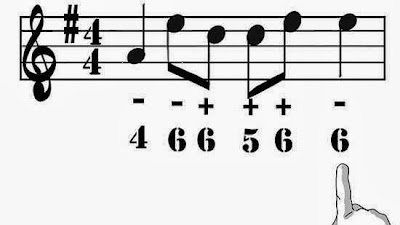Home » Posts filed under Harmonica
Basic Harmonica Technique 1
Make a note by blowing. The very first thing to practice with your new instrument is making a note. Pick a hole or a set of holes on the mouthpiece and blow gently into them. Neighboring holes are typically designed to harmonize with each other automatically, so try blowing into three holes at once to make a pleasing sound. Practice switching between only playing one hole, and playing chords on multiple holes.
- This type of playing is called “straight-harp” or “first position.”
- As you might suspect, the number of holes you blow through is partly controlled by your lips. To allow greater control over the notes you play, you'll eventually learn to use the blade of your tongue to block holes as well. This is covered later.
You must readmore Learn Your Harmonica, Easy To Choose Harmonica, & Learn To Read Harmonica Tablature.
Related : Basic Harmonica Technique, Make a Note by Blowing Harmonica
Learn To Read Harmonica Tablature
Learn To Read Harmonica Tablature. Like guitars, harmonicas can be played by following tablature, which reduces the notes on a sheet of music down to an easy-to-follow system of holes and breath patterns. Tablature is useful for larger chromatic harmonicas as well, but it differs somewhat from diatonic tablature, and is less common.
- Breathing is marked by arrows. An up arrow indicates a breath out; a down arrow indicates a breath in.
Most holes on a diatonic harmonica produce two “neighbor” notes on a given scale; thus playing C and then D on the same scale is accomplished by blowing into the appropriate hole, and then drawing in from the same hole.
- Holes are marked with a number, starting from the lowest (left-hand) tone and moving upward. Thus, the lowest two notes are (up) 1 and (down) 1. On a 10-hole harp, the highest note would be (down) 10.
Some notes on a regular 10-hole harmonica overlap, notably (down) 2 and (up) 3. This is necessary to allow proper range for playing scales.
- More advanced techniques are marked with slashes or another small mark. Diagonal slashes through the arrows indicate that note bending (covered later) is required to get the proper tone. Chevrons or slashes on chromatic tablature can also indicate whether or not to hold the button in.
There isn't a standardized system of tablature that's used by all harmonica players. However, once you practice and get comfortable reading one type, most other types will make sense to you quickly.
You must readmore Learn Your Harmonica & Easy To Choose Harmonica.
Related : Learn To Read Harmonica Tablature, How To Read Harmonica Tablature, Harmonica
Learn Your Harmonica
Posted by Unknown
Wednesday, November 13, 2013
Learn about your harmonica. The harmonica is a reed instrument that uses brass reeds. The reeds are what split the air you push or pull through the holes to create tones. Reeds are mounted on a plate, sensibly called the reed plate, which is also usually made of brass. The part of the harmonica that the reed plate is mounted to is called the comb, and is typically made of plastic or metal. The mouthpiece of the harp may be integrated into the comb, or in chromatic harmonicas, screwed on separately. The cover plates cover the rest of the apparatus, and can be made of wood, metal, or plastic.
- A chromatic harp's sliding bar is also usually made of metal.
- Depending on whether you inhale or exhale through your harp, different notes are produced by the reeds. A typical diatonic harp tuned to C on the exhale is tuned to G on the inhale. These scales complement each other nicely, each filling in the other without having to add extra holes.
- The reeds inside your harmonica are delicate and will wear out over time. Gentle playing and regular care are required to maintain a good tone as long as possible.
Related : Learn Your Harmonica, To Learn Your Harmonica, Learn Harmonica





























